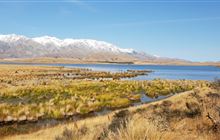Ramsar Convention on Wetlands
Introduction
The Ramsar Convention on Wetlands is an intergovernmental treaty for the conservation and wise use of wetlands and their resources.DOC is New Zealand's lead agency for this Convention and manages most of New Zealand’s Ramsar wetlands of international importance.
Parties to the Convention:
- designate wetlands for inclusion on the List of Wetlands of International Importance
- promote the significance of these wetlands and monitor and advise of any changes to their ecological character
- promote the wise use of all wetlands, especially through national policy on wetland conservation management
- promote conservation of wetlands and waterfowl by establishing nature reserves on wetlands to compensate for any loss of wetland resources of listed sites, encourage research, increase waterfowl populations and promote training in wetlands research and management
- promote international cooperation in wetlands conservation, including the sharing of resources and expertise.
History of the Ramsar Convention.
World Wetlands Day
The Ramsar Convention on Wetlands is celebrated by World Wetlands Day on 2 February each year. This date marks the anniversary of its signing on 2 February 1971.
More about World Wetlands Day.
National reporting on implementation
All Ramsar Convention Contracting Parties are required to submit regular reports to the Ramsar Secretariat. These reports cover:
- work to implement the Convention, and
- on the management of sites that have been listed as Wetlands of International Importance.
DOC takes a coordinating role in the preparation of these national reports.
New Zealand's previous reports on the implementation of the Ramsar Convention on Wetlands.
The Global Wetland Outlook draws on national reports and other sources to summarise:
- global wetland extent
- trends
- drivers of change, and
- the steps needed to maintain or restore their ecological character.
New Zealand Ramsar sites
As a party to the Convention, New Zealand is required to regularly update information on the status of its Ramsar Sites. This is done by updating the Ramsar Information Sheet (RIS) for each site and submitting it to the Ramsar Secretariat, at least every seven years.
The RIS updates are an important milestone in evaluating our effectiveness in maintaining the ecological condition and values of Ramsar Sites. On behalf of New Zealand, DOC submitted updated RISs for five Ramsar sites on 2 February 2022. View the reports on the Ramsar website.
New Zealand Wetlands of International Importance
New Zealand has listed seven sites covering almost 68,000 hectares for inclusion in the List of Wetlands of International Importance (Ramsar sites). They are:
- Whangamarino, Waikato
- Kopuatai Peat Dome, Waikato
- Firth of Thames, Waikato
- Manawatu River Estuary, Manawatu
- Wairarapa Moana, Wairarapa
- Farewell Spit, Nelson
- Awarua Wetland/Waituna Lagoon, Southland
More about these New Zealand Ramsar sites from Ramsar.
Wetlands selected for the list are internationally significant in terms of ecology, botany, zoology, limnology or hydrology. They also must meet criteria outlined in the Ramsar Convention on Wetlands.
Nominations for the List can be generated by agencies or individuals. DOC, as New Zealand’s administering authority, is required to provide advice to the Minister of Conservation on the suitability of any proposed Ramsar site nomination.
DOC can provide further advice on procedures for nominating sites for listing wetlands of international importance.
National guidelines for the assessment of potential Ramsar wetlands in New Zealand
These guidelines assist those nominating or assessing candidate Ramsar sites in New Zealand by providing information about each of the three phases of site assessment.
New Zealand became a signatory to the Convention on Wetlands of International Importance (Ramsar Convention) in 1976. A key aim of the Ramsar Convention is for each Contracting Party to designate sites of international importance based on nine criteria.
These guidelines are intended to assist those nominating or assessing candidate Ramsar sites in New Zealand. They help by providing information about each of the three phases of site assessment:
- ‘Identify’, which includes defining the boundaries of the site
- ‘Describe’, which involves determining the relevant biogeographic region, classifying wetland types and collating information on ecological values
- ‘Assess’, where the level of compliance of the site with the Ramsar criteria is assessed to determine the importance of the site.
A standardised approach for assessing sites against each of the Ramsar criteria is presented.
The application of these guidelines ensures a strategic approach to future site nominations. They will provide a transparent and systematic process for assessing the national and international importance of potential Ramsar sites in New Zealand.
National guidelines for the assessment of potential Ramsar wetlands in New Zealand (PDF, 667K)
Other publications
New Zealand's report on the implementation of the Ramsar Convention on Wetlands:
- 2018 report (PDF, 505K) 13th Meeting of the Conference of the Contracting Parties, Dubai, United Arab Emirates, 2018.
- 2015 report (PDF, 505K)12th meeting, Punta del Este, Uruguay, 1-9 June 2015
- 2011 report (PDF, 258K) 11th meeting, Bucharest, Romania, June 2012
Ramsar Convention on Wetlands 10th Conference of Parties factsheet (PDF, 533K)
Contact
DOC Ramsar National Focal Point contact details on the Ramsar website.


